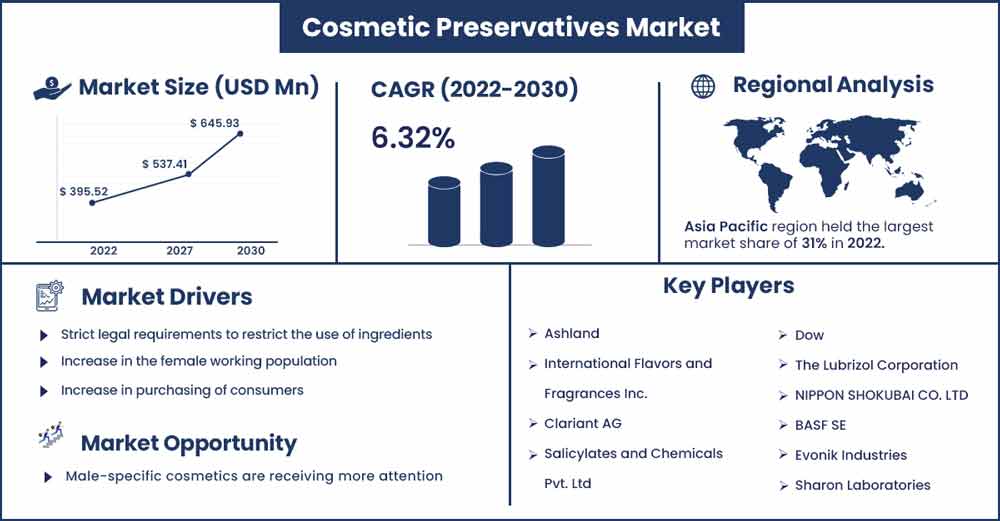December 2024
The global cosmetic preservatives market size was evaluated at USD 395.52 million in 2022 and is projected to attain around USD 645.93 million by 2030, growing at a CAGR of 6.32% during the forecast period from 2022 to 2030.

Preservatives are essential components that are frequently included to daily-used cosmetic and personal care products with the main goal of preventing deterioration brought on by microbial development. Water is one of the most common elements in cosmetic products, and microorganisms may develop quickly in it. Furthermore, the vitamins, minerals, and other active components found in cosmetics can serve as specialized microbe food. Face masks, lotions, sunscreens, and scrubs are the most common products that contain preservatives in their manufacturing. Oil extracts from plants like curry leaf, cinnamon leaf, and clove bud are common natural preservatives. Parabens, formaldehyde releasers, isothiazolinones, phenoxyethanol, and organic acids are typical examples of artificial preservatives. There are several different cosmetic preservatives on the market, including wet wipes, rinse-off, and leave-on.
Report Highlights:
Regional Snapshots:
The biggest market share was held by the Asia-Pacific in the cosmetic preservatives market during the forecast period. Due to the increasing use of sunscreen lotions, conditioners, anti-aging creams, and shampoos, the Asia Pacific region is anticipated to have the quickest growth. The largest skincare market, accounting for approximately 35% of the market, is in the Asia Pacific region. Growing dermatological awareness and the need for plant and herbal extracts in cosmetic applications are both fueling the expansion of the Asia Pacific cosmetics preservatives market.
Cosmetic Preservatives Market Report Scope:
| Report Coverage | Details |
| Market Revenue in 2023 | USD 420.53 Million |
| Projected Forecast Revenue in 2030 | USD 645.93 Million |
| Growth Rate from 2022 to 2030 | CAGR of 6.32% |
| Largest Market | Asia-Pacific |
| Base Year | 2022 |
| Forecast Period | 2022 To 2030 |
| Regions Covered | North America, Europe, Asia-Pacific, Latin America, and Middle East & Africa |
Market Dynamics:
Drivers:
Women are increasingly joining the workforce on a worldwide scale. A survey claims that in 2022, 36% of women worldwide who worked in organized industries were from India. In 2022, working women made up 66.2% of the population, according to a study by the European Union Commission. In the US, working women made up around 56.2% of the population in 2022, according to the Bureau of Labor Statistics. Women are more likely to be employed now, which gives them more financial freedom and the ability to make their own decisions. Women throughout the world are the biggest users of cosmetics. Financial freedom is therefore anticipated to increase the use of cosmetic preservatives by raising the use of cosmetics and skincare products. Moreover, the rising expenditure of personal care products is the main factor driving the global cosmetic preservatives market. The inclusion of advanced preservatives has resulted from the increase in demand for multifunctional and high-end cosmetics, supporting the expansion of the cosmetic preservatives market. Growing consumer preference and awareness of cosmetic preservatives may have a positive effect on product demand. The accessibility of both natural and artificial preservatives fosters industry expansion.
A variety of components can be found in cosmetic goods. Preservatives for cosmetics, distinctive perfumes, and washing agents all fall under this category. Regulatory agencies constantly take steps to restrict the use of chemicals that have negative health effects. The usage of natural cosmetic preservatives in the production of cosmetic goods is subject to strict government laws and regulations, which is anticipated to propel the market for cosmetic preservatives to higher growth rates. Additionally, improvements in living standards, shifting consumer preferences toward the use of natural cosmetic products, the development of shelf life, the availability of both natural and synthetic preservatives, and the growing use of herbal ingredients in cosmetic products are some of the key factors anticipated to propel the growth of the cosmetic preservatives market during the forecast period.
Restraints:
Synthetic substances are used in cosmetic formulations, which can have a number of negative side effects. Organic products are costly due to the higher cost of raw materials. Hence, this element hampers the growth of the market.
Opportunities:
People today are more likely to use cosmetics that improve their appearance. Male-specific cosmetics, including moisturizers, anti-aging products, and mud masks, are in high demand. Younger men experience a number of issues, including hair loss, greasy skin, acne, and wrinkles. With the use of good, natural cosmetic preservatives and an understanding of the usage of the right cosmetic preservatives, all these issues may be resolved. As a result, substantial potential exists for the expansion of cosmetic preservatives that target the male market in particular.
Challenges:
A variety of undesirable consequences are related to the usage of synthetic cosmetic preservatives in the manufacture of cosmetic items. For instance, chronic use of hydroquinone is unhealthy because it irritates the respiratory system, causes skin cancer, and is toxic to organ systems. When used widely as a cosmetic, mercury can lighten skin tone and lessen black spots, but it can also affect the brain, kidneys, and liver.
Recent Developments:
In April 2022- At in-cosmetics worldwide in France and Paris, Ashland unveiled advancements in biodegradable and naturally derived personal care products. Styleze es-dura, Caressense biofunctional, Sensiva, and Texturpure sa-1, the first in a line of high-performing natural, nature-derived, and biodegradable skin and hair care products, are just a few of the goods Ashland has released.
Major Key Players:
Market Segmentation:
By Product
By Application
By Raw Material
Buy this Research Report@ https://www.precedenceresearch.com/checkout/2367
You can place an order or ask any questions, please feel free to contact at sales@precedenceresearch.com | +1 9197 992 333
December 2024
January 2025
April 2025
January 2025